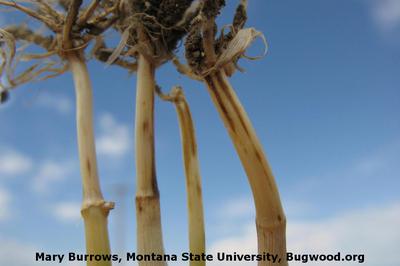Root and Foot Rot
Cochliobolus sativus
Nấm
Tóm lại
- Brown areas at the base of the stem and roots.
- Elongated, brown-black spots on lower leaves.
- Premature bleaching of spikelets or entire head.
- Yellow colored and stunted plants.
Cũng có thể được tìm thấy ở
Triệu chứng
Symptoms will depend on the environmental conditions and the plant growth stage. In some cases, contaminated seeds can give rise to seedling blight, which is characterized by the appearance of dark brown areas on young plants. Early infection of mature plants may not produce symptoms, except for a decrease in leaf area and number of tillers. However, dark-brown areas may be present at the base of the stem (foot rot) or below ground, and on internodes and roots (root rot). Later on, as the pathogen progresses into the stem, elongated, brown-black spots appear on lower leaves. This is particularly evident during prolonged periods of rain. Diseased plants occur randomly or in irregular patches, and are stunted and often chlorotic. A common symptom of late infections is the premature bleaching of one or more spikelets or the entire head (head blight).
Các khuyến nghị

Kiểm soát hữu cơ
The fungus of Sporobolomyces roseus is a natural enemy of Cochliobolus sativus and has been used in cereals to reduce the incidence and severity of the disease. Other antagonists of this pathogen are also available.

Kiểm soát hóa học
Always consider an integrated approach of both preventive measures and biological treatments if available. Seed treatment with a suitable fungicide reduces the potential of carry over of the inoculum on seeds to other seasons.
Nguyên nhân gây bệnh
The symptoms are caused by the fungi Cochliobolus sativus, which is common in warm and humid cereal-growing areas. It survives as mycelium or spores in soil and crop debris, and is spread by wind, rain splashes or irrigation water onto healthy plants. Beside barley, wheat and rye, it can also infect a number of species of weeds and grasses. Oat is resistant to the disease but can still contribute to the dispersal of the pathogen. When a susceptible host is found and conditions are favorable, its spores germinate and initiate a primary infection on the young plant or its roots. It penetrates plant tissues either directly through the epidermis or via natural pores or wounds. Infested seed or agricultural tools can also disseminate the pathogen over long distances and serve as inoculum for subsequent crops. The life cycle of the fungus is favored by warm temperatures (optimal 28-32ºC).
Biện pháp Phòng ngừa
- Be aware of quarantine regulation for this pathogen.
- Select certified disease-free seeds.
- Have a proper fertilization program with split application of nitrogen.
- Make sure to add micronutrient to fortify your crop.



